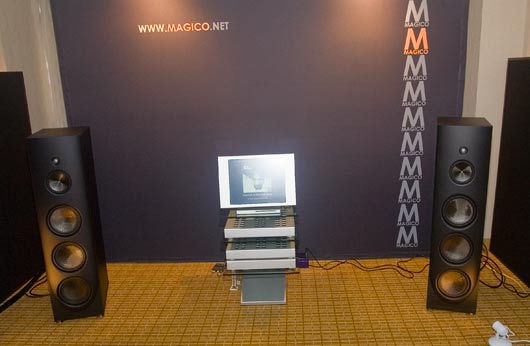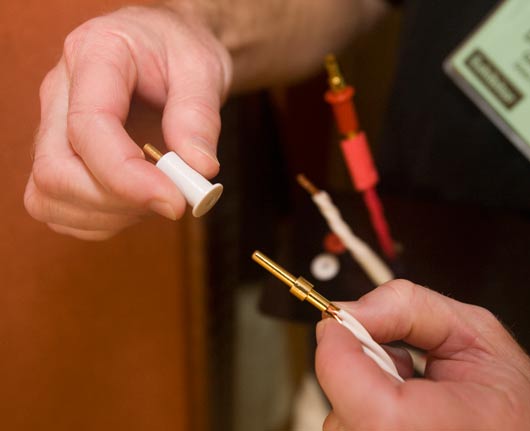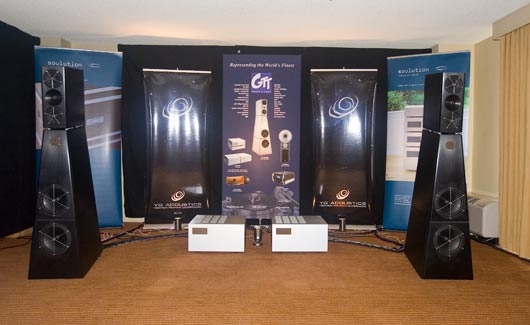It took me awhile to figure out what to think about the sound of this system. I kept thinking that there was something hauntingly familiar about the sound.
It was very even top to bottom, even the dynamics were even-handed top to bottom. There was a lot of detail [midi-detail and macro-detail, micro-details were not glaringly absent, but they were weaker than what I would call natural]. Tone was good solid-state-ish tone. Harmonic resolution was typical for solid-state [aka not all that good, but it *is* solid-state]. There was good image stability and good separation – although something was happening during complex passages that seemed unnatural – like one channel was happening ‘before’ the other channel or something – that prevented that lovely effect of allowing one to hear every instrument as a separate entity when everyone is playing at once.

So. One interpretation of all of this is…
That this is a realization of the way I thought [and many still think] a stereo system should sound when I was a young geek. I was way into math and physics and the engineering sciences. I would have wanted a system that had as source material something as close to the master tapes as possible and recorded it in as high a resolution as was possible. Then I would have used a dedicated computer music server to deliver it to a solid state amp of low distortion, probably after passing it through a room correction device. Finally this system would have speakers that measured very, very well.
This is what I saw in this room.
Well, now I am an old geek.
This is not a derogatory perspective. And this system is not like TaCT which MANIPULATES the signal in the pursuit of some goal mathematically arrived at. The system in the Magico room tries to PRESERVE the signal by methods mathematically arrived at.

There are many reasons people buy audio equipment. If we break those reasons down into general categories we have the:
BOY’S TOYS: big and small noise makers. There are a fracking [the Battlestar Galactica Finale sucked so very, very much – but I like using their colorful words] lot of these at the show. [YG Acoustics/Soulution, Wilson/ARC, Focal/whatever, TAD/whatever, etc.]
COOL GADGETS: technology at its newest buzzword- and acronym-generating mind-expandingly best
PRACTICAL APPLIANCES: Systems that let one play music at home and be able to enjoy it to some extent
DRUGS: Systems that try to reproduce music in ways that ‘feed your head’ [yes, drugs may be too flippant a word, and we’ve used both MAGICAL and SPIRITUAL to describe this in the past. But I am trying to add a little humor and also to reach people who might think the previous words too ‘newage-y’ or just plain opaque]
Many systems mix and match various quantities of these 4 audiophile food groups.
I think the Magico system in the room at RMAF did the COOL GADGETS thing and that no one else is really doing it front-to-back like this. Many rooms do something like this – notably the Kimber room uses similar high-quality source material, but everyone mucks it up somewhere in the chain.
See, this system SOUNDED like a Cool Gadget system, and that makes it a grown-up BOY’S TOY. I think that if a system like this was marketed this way – that it might be quite successful with real people [you know who I mean. Those non-audiophiles that seem to appear out of the woodwork at grocery stores and can be seen walking down the street during the daylight hours].
That said, this system would be an example of what is commonly called a ‘soulless’ system. This was the primary comment people had about this room.
The Magico room system degrades into an impressive BOY’S TOY [mostly because COOL GADGET systems do not primarily connect one with the music so much as connecting one with the awesome world of technology].
I am personally interested in systems as DRUGS. I want to get high on my music. I want to experience new and intensely aesthetic perspectives on life and living. I want my system to be so good that I have no choice but to be forcibly projected into another dimension better than this one [:-) seriously, it is instead a more accurate and timeless view of the true reality of this dimension – that is too often obscured by the ever present noise of people yelling at us wanting to convince us of something. I SAID ‘seriously’… :-)]. I am too busy [to have the time to listen for hours before I get a buzz] and too worried about the world going to hell [the music has to be very powerful in order to work at all] and too cynical [the musical goodness has to be so good and so subtle and encompassing that it can sneak up on the nasty ole suspicious ‘nothing can brighten my day’ me]. And at the low end, I want my systems to smoothly degrade into being PRACTICAL [i.e. built on a PRACTICAL foundation] .
There is a point here I want to make. It is cool wanting and buying a COOL GADGET system. No question about it. Maybe someone just wants to have fun, or expands their minds in the old fashioned way 🙂 or whatever.
I just think it is important for people to recognize that systems have different purposes – and that lumping them all together is very misleading and confusing. That the more we identify and categorize [yes, I know that categorization leads to closed-mindedness – but, seriously, things are just too chaotic] the better it will be for people who want to enter this hobby. You know, just like cars are divided into ‘sports cars’ and ‘luxury cars’ and ‘SUV’s?.




